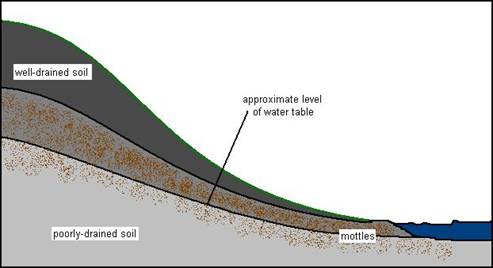Competency Area 3: Drainage and irrigation AEM
PO 17. Understand how hydrology and soil and landscape properties influence drainage class and drainage criteria.
The soil drainage classification is based on a variety of physical, chemical and biological indicators and interactions that occurred over a long time period. From a hydrology perspective, the depth of the water table below the surface, the extent of the rise and fall (fluctuation) of the water table, and the time of duration that the water table is near the surface are important indicators. The water table may reach the surface of a well drained soil, but if this happens very infrequently, it doesn't cause it to be a poorly drained soil.
A very poorly drained soil classification arises out of the criteria that the water table not only reach or even exceed the surface (flood), but also that it remain close to the surface for the entire year duration, even during the summer months when evapotranspiration rates are high. A poorly drained soil on the top of a hill is usually caused by the presence of some impermeable underlying layer. Nevertheless, poorly drained soils are more likely to be found at the base of hills and in low-lying areas of a watershed where water collects.
Long term anaerobic soil conditions reduce manganese and iron which results in grey/green/blue staining of soil peds as shown in the poorly drained classification. Where the water table rises and falls, the soil goes through brief periods of anaerobic and aerobic conditions respectively, which cause iron to oxidize and produce the red/brown/yellow/orange staining (mottles) on soil ped interfaces as shown in the diagram below.

Quick Links
- Competency Area 1: Basic soil properties
- Competency Area 2: Soil hydrology AEM
- Competency Area 3: Drainage and irrigation AEM
- Competency Area 4: Soil health and compaction
- Competency Area 5: Soil conservation AEM
- Competency Area 6: Watershed hydrology AEM
- Competency Area 7: Non-point source pollution AEM
- Competency Area 8: Concentrated source pollution AEM
- Competency Area 9: Conservation planning AEM
